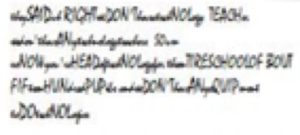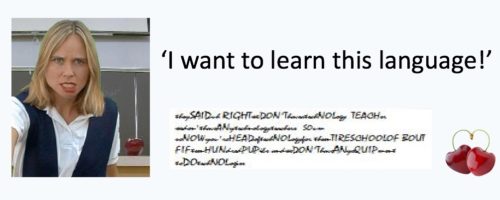Listening Cherry 28 – Distorted blur
In this blog I will attempt to demonstrate, using distorted orthography, the difficulties involved in learning to listen in a language in which you are not yet expert (second language learning). First, I need to tell you about Anna’s anger.
Anna is a friend of mine (a very prominent professor of English) whose first language was not English, she had to learn it at school. When she was a student, she hated the approach of one of her teachers to listening lessons. And she told me:
…I’ve hated the underuse of the material. I’ve … answered three silly questions … then someone tells me patronisingly (it IS bloody patronising) that the rest doesn’t matter. Well it does if I want to learn the language!
Let’s explore the kind of classroom activity that might have made her angry. Because this is a written blog (in sight substance) I am going to transpose her listening comprehension activity into a reading comprehension exercise (using distorted orthography) on a very short text.
Here is the teacher’s introduction (remember I am recreating in reading-activity form what was a listening activity, so this is not actuality).
You will read about a young woman, Emily, who was given a teaching job in a school in South Africa. She had gone there to work as a young volunteer, at the age of eighteen, before coming back to the UK to enter university. Read the following questions – there are three choices of answer, and then read – scan – the text to find the answers.
- What subject was she given to teach? (a) Maths (b) English or (c) Technology
- How many pupils were in the school? (a) 500 (b) 1500 (c) 2000
- How many times did the word ‘teacher’ occur? (a) Once (b) Twice (c) Three times

(What you are looking at, and inspecting, is a blurred version of an orthographic transcription. There are a few differences from normal orthography: upper case letters are for prominent syllables, and lower case letters are for non-prominent syllables – the mush of speech.)
Having given the students time to arrive at answers, the teacher would then ask the class what they thought the answers were, and praise them for getting the answers which are:
- What subject …? (c) Technology
- How many pupils …? (b) 1500
- How many times … ‘teacher’? (b) Twice
If our teacher were Anna’s teacher, he/she would move on to another activity – refusing to answer any other questions, because, having arrived at the answers, there is – in his/her view nothing else to do. The communicative act of arriving at an understanding of the meaning has been achieved, so the teacher believes that their work is done as far as this activity is concerned.
But remember that Anna wants to learn the language. And because (in this blog) the language is presented as sight substance (albeit blurred), it remains available for inspection. This is completely unlike sound substance, which will have departed the scene, and would therefore be invisible. Out of sight, out of mind – ignorable.
Because (in our imaginary scenario) Anna is looking at sight substance, she and her fellow students can point to the blur and ask: ‘What does this mean?’ But actually (and this is the point) they are more likely to ask ‘What are these words? Because picking out the words in this blurred sight substance is difficult.
Anna’s desire to learn the language is not satisfied by having done the communicative task of answering the questions. She wants to stay with the substance, and improve her ability to recognise words in the substance.
So rather than walk away from the substance, what could Anna’s teacher have done in the listening lesson? (We now revert to sound substance). The answer is simple: stay with the sound substance of the recording. Always, always, always allow time for this question:
Now that you know the answers, listen again, and try and identify the words that lead to the correct answers.
Then, always always always, do something with a short extract (which either you or your students choose) and go to work on it. Ask them how the words in the selected extract sound to them, and tell them how they sound to you. Do vocal gymnastics (see here), get them to savour different ways of saying the words: different speeds, different accents, severely reduced, extra carefully elongated. Encourage them to create raps, or ear-worms. (More on this in future blogs, and in A Syllabus for Listening (forthcoming).



Leave a Reply